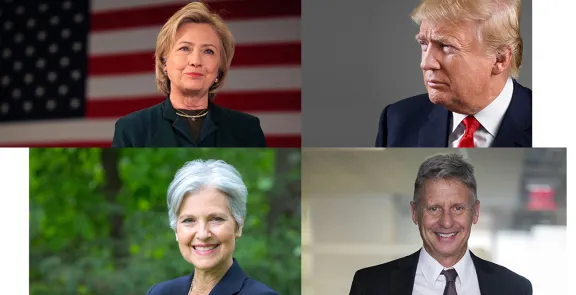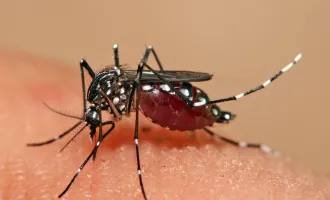
Obamacare at Stake in Presidential Election
This election cycle has been a ride, hasn’t it? Donald Trump is grabbing everything but Republican endorsements, Hillary Clinton is proving that the permanent problems are the ones you delete, Gary Johnson is still figuring out what Aleppo is, and Jill Stein – well, her lack of media attention has probably bolstered her credibility more than anything.
Come November 8, you will be tasked to vote on important issues, both local and national, and it’s important to be informed in order to make those tough decisions on Election Day. Let’s begin by highlighting the candidates’ policies on the issues that matter most to UCSF – healthcare and science.
Healthcare
In essence, the two main candidates’ healthcare stances revolve around what to do with the Patient Protection and Affordable Care Act, also known as Obamacare. Trump seeks to replace Obamacare entirely, while Clinton will keep basic tenets of the act in place and build upon it.
What would replace the Affordable Care Act? The free market, of course.
In Trump’s plan, the individual mandate for healthcare would be lifted and individuals would be able to purchase insurance across state lines with a call for price transparency from health providers.
As he states on his campaign website, “By allowing full competition in this market, insurance costs will go down and consumer satisfaction will go up.”
Additionally, payments toward health insurance premiums would be fully deductible for the individual, extending a cut that is usually reserved for businesses.
This “free market” approach, along with repealing much of the regulations and requirements of the ACA, is likely to cause a huge variability in plans across the country, to say the least.
Alternatively, individuals would also be eligible for Health Savings Accounts (HSAs), which are tax-free savings accounts used in conjunction with a high-deductible health plan. Essentially, HSAs would not be taxed and could be used as the holder sees fit, but in exchange they would be paying much higher up-front costs due to lower premiums as part of their plan.
These accounts, which could be shared among family members, would “be particularly attractive to young people who are healthy and can afford high-deductible insurance plans,” which I’m sure would cover all of you young and affluent readers of Synapse.
For those that cannot afford insurance, Trump asserts that “we must review basic options for Medicaid and work with states to ensure that those who want healthcare coverage can have it.”
Medicaid in this administration would come in the form of block-grants, lump sums of money given to the states to use as they see fit. This is in opposition to the current system, in which the federal government funds a percentage of Medicaid to states in exchange for meeting specific requirements of coverage and eligibility.
For those in need, this is basically a non-answer. But the campaign likely expects this population to be negligible because everyone will have jobs. The best jobs.
To combat the rising cost of premiums, Clinton’s plan works within the ACA by increasing tax credits to those buying insurance through the Marketplaces, where the uninsured shop for plans within their state.
She also vows to grant the Secretary of Health and Human Services (from her website) “the authority to block or modify unreasonable health insurance premium rate increases so that coverage is more affordable.”
In an unexpected twist, both candidates also appear to agree on increasing transparency among health providers. Her plan proposes to reduce out-of-pocket costs up front through additional tax credits ($2500 per individual, $5000 per family) for individuals or families with payments exceeding 5% of their income, if not already receiving Medicare or other deductions.
The plan also includes provisions to allow three sick visits per year that are non-deductible, saving up to $100 annually for an individual with private coverage, according to her website.
To indirectly bring down such costs, she also proposes to encourage a shift from a “fee for service” system, in which individual services and procedures are paid for, to a “bundle” system.
As she writes, “We need to implement new and expand existing systems that pay for an entire episode of care or “bundle,” or those that incentivize doctors and hospitals to coordinate care in an Accountable Care Organization, so that providers are responsible for offering the best possible care at the highest value to patients – rather than letting costs rise higher and higher without more effective care.”
Whereas Trump’s healthcare policies are likely to reduce coverage, Clinton’s plan aims toward expanding coverage to a wider range of Americans. Under her administration, Medicaid would be expanded across all states, immigrants would be able to purchase insurance regardless of status, and those 55 years or older would be able to opt in to Medicare.
Although specifics aren’t detailed, Clinton also proposes to work with states to offer a “public-option insurance plan,” which is assumedly a foot-in-the-door for true nationalized healthcare.
Between the extensive tax credits and expansion of coverage, Clinton’s plan is going to cost a pretty penny. Like most of her policies, we can expect that she will attempt to pay for her healthcare plan by beating the 1% with taxes until all of their Monopoly money falls out.
The third-party candidates have less defined stances on healthcare. Gary Johnson, for instance, does not even have a section for healthcare on his website. From his past interviews, however, it appears that his views align with Trump’s on the concept of a “free market approach” by extending block-grants to states for them to decide on how to spend the money.
Jill Stein, on the other hand, believes in healthcare as a right, and would create a “Medicare-for-all” single-payer system to provide everyone with healthcare. This was listed under other achievable dreams on her website, like “End Poverty.”
On Science
The candidates’ views on science, research, and technology are relatively sparse, and mostly skew toward hot-button issues like GMOs, clean energy, and specific illnesses.
As a result, no candidate emphasizes this general topic on their respective websites. However, all four candidates have given their most comprehensive answers on website sciencedebate.org, which I will summarize here.
Trump vaguely expresses an interest in investing in science and research, though repeatedly emphasizes that work must be done to establish priorities to allocate scarce funding resources. He also advocates management of STEM education at the state and local level rather than influences by the Department of Education.
If we are to follow his line of thought for most issues, we can be sure that breakthroughs in scientific research will follow the defeat of ISIS.
Clinton also encourages funding science and research in more precise terms, though without the same caution for prioritization and resources as Trump. Specifically, she plans to actually increase investments into the NIH and in research ventures on diseases like Alzheimer’s.
Increasing communication between scientific institutions and government is another goal: “The government has a critical role to play at this stage by opening access to and sharing government-funded research results. I will support the development of collaborative consortia that accelerate the creation of new industries while providing valuable feedback to researchers.”
For science education, she plans to expand initiatives to increase education in computer science and initiatives that engage underrepresented populations in STEM fields. Her proposal of debt-free college may also have an indirect effect of bringing in more students into STEM.
Johnson favors prioritization of federal funding, similar to Trump, but actually provides more specifics. He believes public funding should be used “for basic science and limiting funding for applied science to that which has clear public benefit, but isn’t feasible in the private sector.
The Johnson-Weld administration defines basic science as research that works towards understanding of fundamental issues at the core of scientific disciplines.” For applied science that could result in profitable outcomes, Johnson strongly encourages funding from private companies with as little government involvement as possible.
Like Trump, he also advocates pushing STEM education policy to the states.
Jill Stein takes a more ground-up approach to broadening scientific research – her responses focus on ending poverty and granting free education for all as a means of removing barriers to give opportunity for people to enter STEM fields.
In regards to scientific institutions like the NSF and NIH, she writes, “We will revisit these institutions--their charge, focus, and operations--to ensure that they're performing as expected. We will look for opportunities and mechanisms whereby science policy can be made more democratic, and more responsive to the preferences and needs of average citizens.”
But what’s important is you... VOTE
All sarcasm aside, I do hope this article has been informative in covering policies most relevant to UCSF. Almost all of this information can be found at the respective candidate’s websites or reports from the Kaiser Family Foundation if you want to learn more.
Most of you will have probably already made up your mind on how you feel about each candidate, and even so, the most important thing is that you show up to the voting booth on November 8 and cast an informed vote on what matters to you.
Keep in mind a few things when you think about whether or not you should vote, and the decisions you make when you do vote:
There is more at stake than just choosing the presidential candidate. You will be voting on propositions that immediately affect where you live and electing officials that will hopefully represent your ideals. Change occurs from the ground up, and you will be contributing to the foundation that is tomorrow’s policy.
Whatever you do, remember that your decision will affect people beyond yourself. Sit and really think about that. Take a walk. Look at the people around you. Ruminate on the toilet. Think about how others will be influenced by policy and those in power. Not casting a vote may not hurt you too much in the long run, but that choice may hurt many others. The same could be said of making an uninformed vote.
Remember that voting makes you a statistic, in a very meaningful way. Whoever you are, you represent a demographic. Even in the most cynical interpretation, politicians will pander to where the votes are. If you don’t vote, you weaken the power of your demographic, politicians in turn don’t cater policy to you, and the country pulls away from your values.
So please, whatever you do, get to the voting booth on Election Day and cast your vote(s). It does matter.


